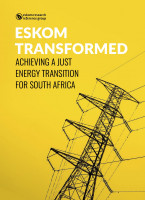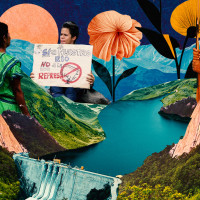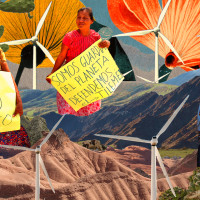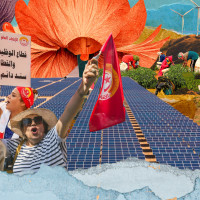Democratising Eskom in South Africa Energy transition country struggle
Regions
Eskom, South Africa’s state utility, crumbles under debt, corruption, and blackouts. As privatisation looms under President Ramaphosa, trade unions and civil groups rally for a public-led renewable energy transition. Can Eskom reclaim its role as a reliable, people-focused energy provider?
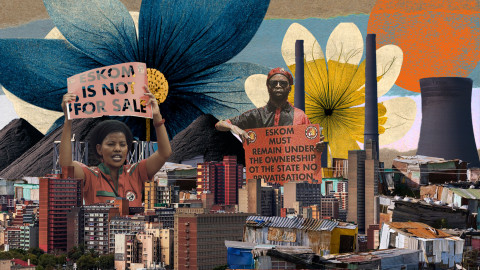
Illustration by Fourate Chahal El Rekaby
The commercialisation of Eskom
Formed in 1923 as a public service and not-for-profit utility, Eskom was legally mandated to provide electricity at cost price and to ensure all projects including new generation were in the public benefit. It became known for providing the world’s cheapest electricity to South Africa’s white minority.8 The low prices were in part due to the racist policies underpinning service delivery.9 Indeed, racism permeated through the whole organisation, with the majority of jobs and coal contracts going to white workers and white-owned firms.10 Under apartheid, the company refused to provide electricity to townships or rural areas where the majority of the black population was forced to live.
In 1989, amid the national process that would abolish apartheid, Eskom launched their ‘Electricity for All’ slogan, with the stated intent to improve access to electricity for black South Africans.11 Yet this did very little to alleviate energy inequality across the country, with sub-par overhead energy installations being used instead of the higher-end infrastructure used to provide electricity to the white minority.12 Racist discrimination in service delivery has continued to the present day, with mass disconnections in black small towns and neighbourhoods carried out during the COVID-19 pandemic, in areas where many people were struggling to pay their energy bills.13
That said, post-Apartheid, the ANC government directed Eskom to spearhead impressive progress in advancing electrification across the country, and electrification increased from 31 per cent of the population in 1994 to 66 per cent in 199914 and 85 per cent in 2021.15 However, this advance came alongside an explicit commercialisation agenda. In 1987, Eskom’s not-for-profit status was removed, and the state-owned utility was required to raise capital commercially. The Eskom Amendment Act of 1998 started by transforming the utility into a limited liability company with share capital and largely repealing its tax-exempt status.16 Although the state remained the sole shareholder, the Act explicitly stated a desire to privatise the utility. Privatisation plans did not materialise in the 1990s, but the corporatisation process was completed with the Eskom Conversion Act of 2001. Eskom was converted into a public company with a profit motive and share capital, with the ultimate goal of being listed on the stock exchange.
The Eskom Amendment Act was contained within the 1998 White Paper on Energy Policy. It laid the foundation for both the commercialisation of Eskom in line with the World Bank’s policies, and the unbundling and load shedding taking place today. A five-year moratorium was placed on Eskom investing in any new generation capacity, as the private sector was expected to come on board. Yet private investment remained absent from South Africa’s energy sector, as Eskom’s tariffs were too low for profit-driven companies. Despite warnings from Eskom as early as 1998 that the country was not producing enough energy, the government failed to amend the moratorium.17 In 2007, the consequences of relying on the private sector to solve the country’s energy production capacity shortage were felt nationwide. The state was forced to introduce load shedding to ration energy, with drastic consequences: households were left in the dark for up to eight hours a day due to rolling blackouts, industries had to cease production and hospital care was severely affected. By early 2008, the government called the crisis a ‘national emergency’.18
Under pressure to address this emergency, the national government created an additional crisis in 2008 by investing in the construction of two coal-fired power plants.19 Large amounts of public money were invested in contracting private multinational companies including Alstom (a French multinational) and Hitachi (a Japanese multinational). Alstom’s contract for the second power plant alone amounted to over €1.3 billion – money that could have been invested in renewable energy. At the same time, corruption and mismanagement took their toll on Eskom’s operations. Deals were made under pressure from then-President Zuma, which led to the use of inferior coal, causing damage and disruptions to the plants.20 In November 2014, load shedding was reintroduced, and regular blackouts are still the norm today.21
The fateful decision to invest in two new coal plants was among the leading causes of the escalation of Eskom’s debt and kickstarted the utility’s so-called ‘death spiral’. To finance the construction of the plants, Eskom took out large loans from the World Bank. By 2019, South Africa's debt to the World Bank had more than doubled, as foreign currency had been flowing out of the country and the rand began to lose value. With increasing fees and interest rates, it may take another 80 years to repay this loan.22 A large share of Eskom’s debt is owed to international private debtors, as over 50 per cent of the utility’s debt was sold to the private sector in 2019.23 Due to unfavourable exchange rates, the real value of Eskom’s loans is much higher than a loan in national currency would be, hindering the utility from making progress in repaying its debt.
Eskom’s mismanagement is compounded by its role in the creation of dire health and environmental consequences for many South Africans, due to the deadly levels of pollution the company produces. In 2018, Eskom was found to produce higher levels of NO2 in South Africa than that experienced anywhere else in the world. The situation is particularly severe in the Mpumalanga region, where there are several coal energy generators24 and where nine-tenths of the population are black.25 Despite this one site affecting 10,000 people a day, Eskom’s political power has enabled it to continue to fail to address the air quality crisis.26 A 2021 study by the Centre for Clean Air found Eskom to be the biggest polluter in the world, emitting more SO2 than the US and China combined.27
Privatising renewables
To address the power irregularities and insufficient production capacity, in 2011 the Department of Energy launched the Renewable Energy Independent Power Producer Procurement Programme (REI4P). The aim was to procure renewable energy from the private sector. Through the programme, private investors submit proposals for the development of renewable energy capacity in separate bidding windows. The first four bidding rounds, between 2011 and 2015, saw proposals for an additional 6,327 MW capacity accepted – yet most of this will only be completed after 2024, meaning no progress in easing the country’s pressing energy shortage until then. While REI4P is viewed as a tool to solve load shedding, the country’s reliance on independent power producers has led to price increases, reduced transparency and a further deterioration in Eskom’s financial situation.
One of the biggest corruption scandals involving Eskom and the ruling party took place during this period of low transparency. The ANC’s front company Chancellor House accepted bribes from Hitachi Power Africa to ensure that Hitachi won the tender to run two major Eksom power stations.28 These payments were covered up through false reporting, and the arrangement gave the ANC a 25 per cent share in the company, profits of which were to go directly to Chancellor House and the ANC.29 Eventually, the company was fined $19 million by the US Securities and Exchange Commission for violating the Foreign Corrupt Practices Act. Despite corruption around the power plant being well known, the World Bank lent South Africa $3 billion towards these projects. This left the country with illegitimate debt, and forced Eskom to raise energy prices to cover their costs.30
By 2019, the costs of REI4P were associated with an increase of over 14 per cent in Eskom’s overall revenue requirement.31 Eskom’s Multi-Year Price Determination (2022 to 2025) requested a 32 per cent tariff increase for 2023. A leading factor behind the increase was rapidly rising IPP prices. Currently, IPPs contribute only 8 per cent of total installed capacity, while accounting for approximately a third of primary energy costs.32 The situation is likely to worsen further. Outsourcing renewable energy development to the private sector will deepen Eskom’s death spiral, increasing the utility’s debt by requiring additional investments, while reducing its income. This is compounded by several other factors: 20-year-long power purchase agreements that cannot be renegotiated as demand changes (contracts are hidden from public scrutiny via non-disclosure agreements);33 the need for infrastructure investments in grid and transmission maintenance and additional storage technologies; and the increased costs of integrating and running a grid with a growing share of renewables. All of this will cost more public money and weigh heavily on Eskom’s budget.
Since 2019, President Ramaphosa has pursued plans to unbundle Eskom’s operations, essentially preparing the public utility for privatisation. He has lifted the threshold for private energy generation projects to require licences from 10MW to 100MW.34 This is benefiting large private companies, while smaller-scale community projects have not been able to take advantage, lacking the municipal and state support required to get off the ground.35
Opposing actors, including several trade unions, argue that privatisation will not solve South Africa’s energy crisis – instead, it will see consumer bills rise, reduce access to affordable energy and put public jobs at risk. Those who cannot pay will be left behind in a privatised energy market where corporations are not looking to offer social subsidies that would reduce their profits. What are currently public jobs will be replaced by private sector employment, likely under worse conditions to minimise labour costs. And without massive state subsidies, the private sector is unlikely to be able to raise the level of investment needed to finance an energy transition at the scale and pace needed.
The government has recently announced a new round of ‘green’ structural adjustment. In 2021, it accepted a 13.5 billion rand loan from the World Bank in exchange for signing on to the World Bank Country Partnership Framework, which mandates neoliberal policies such as labour market reforms and measures to encourage foreign direct investment and public–private partnerships. The government argues that this loan is necessary in order to fund its ‘just energy transition plan’. This is a market-led approach to decarbonisation, premised on ending restrictions on new private power generators, the unbundling of Eskom, the deregulation of energy prices and increased private investment in wind and solar.36
In 2023, the government again banned Eskom from generating its own electricity, further reducing its ability to sustainably maintain tariffs and leaving South Africa’s renewable future to private hands. Then, in 2024, the Electricity Regulation Amendment Bill was introduced, cementing the unbundling that is dividing Eskom into separate bodies for generation, transmission and distribution.37 One such body is the National Transmission Company of South Africa (NTCSA), an Eskom subsidiary that is now tasked to buy electricity from Eskom and the many independent power producers.38 Here, we see destructive neoliberal policies being enforced under the auspices of decarbonisation. Such policies are further enforced through the Just Energy Transition Partnership (JETP) international climate finance mechanism (see Section 4.1) . The International Partners Group, the driving force behind the JETPs, made the $8.5 billion JETP loan for South Africa contingent on policy measures such as unbundling.39 By April 2024, Eskom’s unbundling was in full swing with its transmission arm ready to be sold.40


